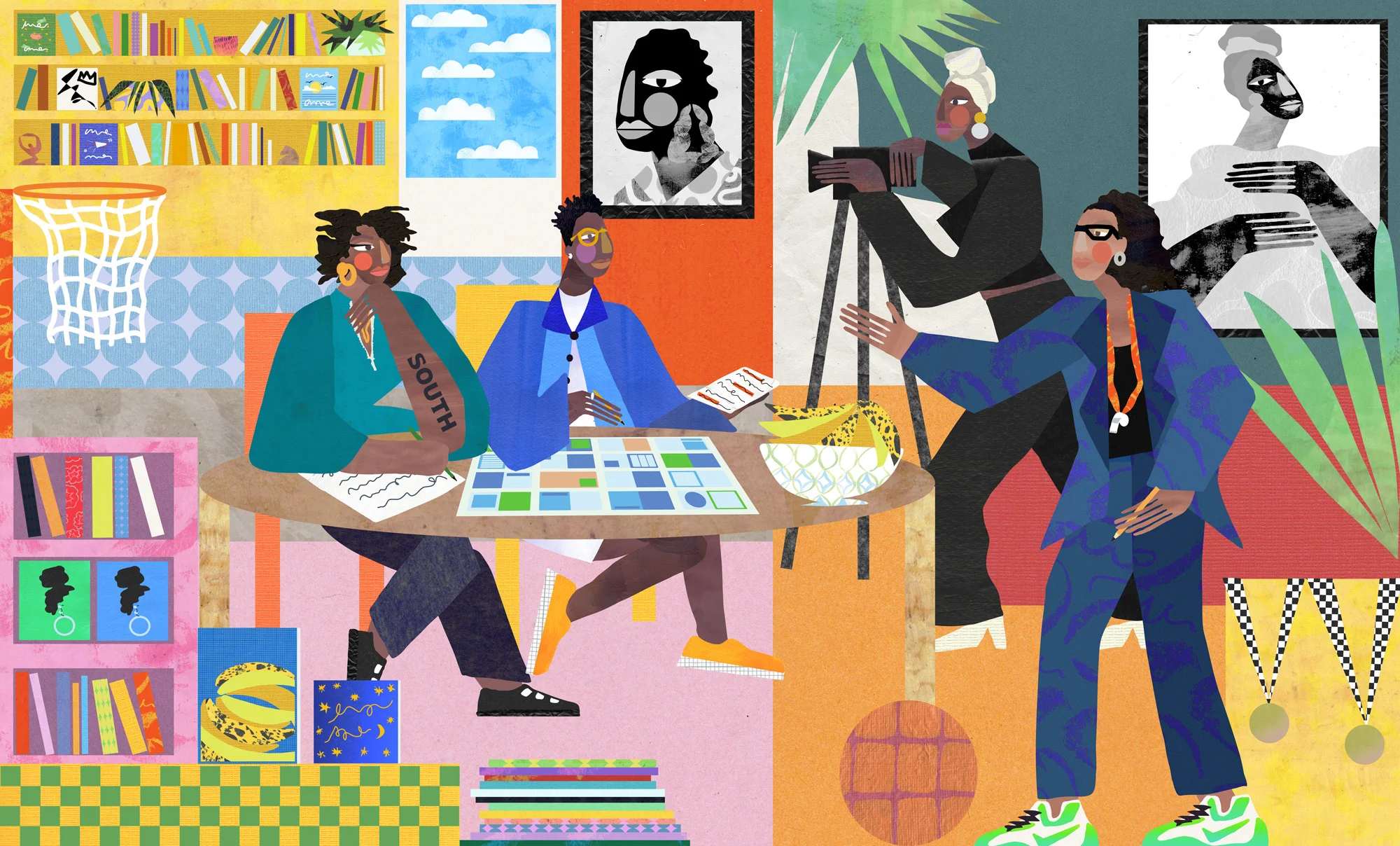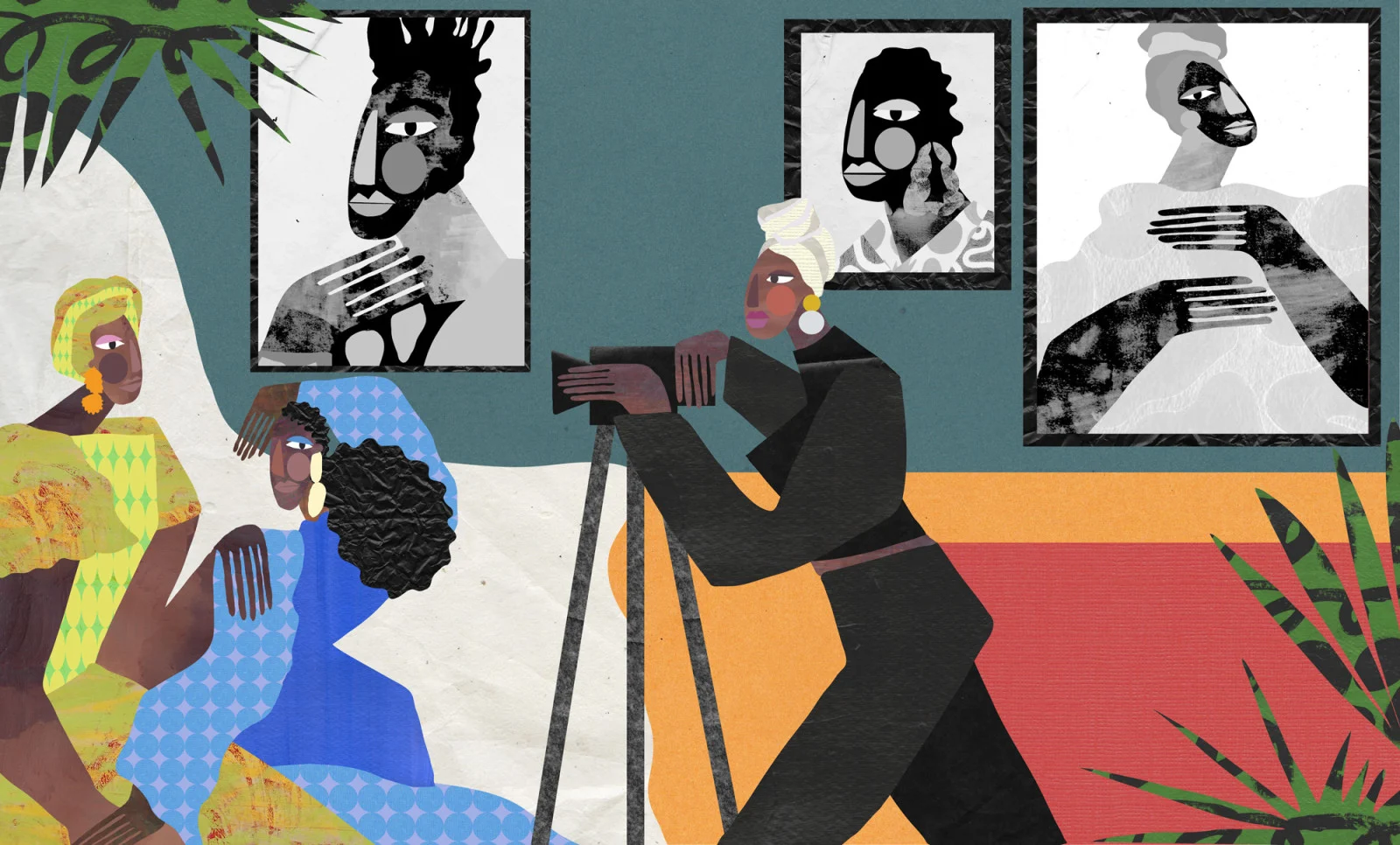

What do studios and employers look for in a great creative team and inspiring collaborators? In partnership with Creative Lives in Progress, we’re launching Team Building; a series setting out to investigate just that. We’ve called upon some shining industry figures to share their ultimate creative collaborators – and what makes each of them so desirable. In the last article of our series, we pass dream-hire duties onto Lemara Lindsay-Prince, senior commissioning editor of #Merky Books, and the co-founder and editor-in-chief of independent print journal, Plantain Papers.
Illustrations by Imo Crossland.

When Lemara Lindsay-Prince was appointed as the commissioning editor of #Merky Books in 2018, she joined an already “incredible” creative team. The first editor to take the helm of Stormzy’s award-winning Penguin Random House imprint, today, Lemara and her team are set on publishing bold voices from untraditional spaces that will own and change the mainstream.
From commissioning How To, a non-fiction book series about topics like activism and branding, to recently securing the rights to publish Jade LB’s coming of age story, Keisha the Sket, Lemara’s drive to share knowledge and capture new voices is clear. It’s something she brings to her pursuits outside of #Merky Books, too, in her role as the co-founder and editor-in-chief, alongside Tamika Abaka-Wood and Tahirah Edwards-Byfield, of annual publication Plantain Papers: a “literary ode to plantain” and those who eat it.
So what does Lemara look for in a solid team? First and foremost, it’s a “diversity of skill, intersectionality and a range of lived experience.” For Lemara, it’s only through bringing your whole self to work, and “meeting people where they’re at” that the possibility to shape and shift culture becomes real.
Added to that, is simply having a common goal: “you shouldn’t be doing everything,” Lemara says. Instead, being able to set aside your own ego and place the reader at the heart of every project is crucial. And for the team at #Merky Books, it’s their shared commitment to uplifting traditionally underrepresented stories and voices that underpins this – something Lemara likens to a dartboard: “That red dot, that’s the end goal; that’s what we’re working to fulfil. I think that’s what makes a good creative team.”
With all of this considered, Lemara’s task of selecting just three candidates for her dream lineup was an admittedly hard task. But after much deliberation, Lemara ultimately came to choose three influential Black women who capture the admirable qualities she looks for in great creative collaborators.

Candice Carty-Williams
If you’re proud of what you do, and you want to keep going, you have to stay competitive.
Not only is Candice Carty-Williams a writer and author of the Sunday Times bestselling novel, Queenie, she’s also one of Lemara’s greatest friends: “She’ll come to my house for a cup of tea and some cookies, or a cake I’ve made, and we’ll just chat,” Lemara tells us. Having known each other long before getting the job at #Merky Books, Candice continues to inspire Lemara, notably for her confidence in using her voice for change: “She uses her platform to share her insight with the world, she also uses it to uplift others. I love the way she will say things boldly and unapologetically, and with so much heart.”
In addition to creating The Guardian and 4th Estate short story prize, and being a mentor for the Penguin Books WriteNow programme, Candice has written widely for the likes of The Guardian, i-D, *Vogue, BEAT Magazine* and Black Ballad. But whether working on a book or sharing something for the culture on social media, Lemara ultimately cites Candice as a “force for good and change” – making her the ideal candidate to collaborate with.
How can you be more like Candice Carty-Williams?
Embrace your identity “Repping where you're from is one way we can all be a bit more like Candice,” Lemara says. Her family hail from Jamaica, and having been a south Londoner all her life, Candice is proud of her heritage; “She doesn’t have ‘SOUTH’ on her forearm for nothing!” In Lemara’s eyes, Candice has been able to paint a more accurate picture of the industry by bringing her lived experience to her work – a quality she’s grateful for and would love to see more of: “There's an image of what publishing is, and it's true,” explains Lemara, “but it's so important to speak as you speak, to look how you look and to show up how you show up.”
Don’t undervalue your voice When you’re just starting out, it’s not uncommon to feel like your voice might not be heard as loudly as those more senior, or established. But, it’s worth remembering that your viewpoint is unique, regardless of your experience. In fact, when Lemara was starting out as a writer herself, Candice read some of her work and gave supportive feedback: “Candice made me feel validated. She taught me the power of using my own voice and the value of having something to say.” So if you’re about to take your first steps into the world of work, then do like Candice does and don’t be afraid to speak your truth, whether in person or through your work.

Adama Jalloh
I like to think of Adama’s photos as building an archive of now.
A portrait and documentary photographer based in south London, Adama has spent her career capturing her local community. Since graduating from Arts University Bournemouth, Adama has published a variety of personal projects and taken on commissions for The New York Times, 10 Magazine and Dazed & Confused among others. Depicting an accurate and honest picture of modern life in the city, Adama has an utter knack for her medium: “there’s something transcendent about her work, it’s so soft, beautiful and intimate,” shares Lemara.
But what Lemara loves most about Adama’s work is her ability to document contemporary culture in a significant way: “I’m really drawn to photography like that.” So much so that she sees Adama as part of a lineage of other great photographers, like James Van Der Zee, Gordon Parks, James Barnor and Vanley Burke. In Lemara’s opinion, the fact that Adama is able to not only pick up a camera, but resultantly record a poignant piece of history, makes her a dream collaborator.
How can you be more like Adama Jalloh?
Be sensitive to your surroundings
Adama uses her photography to document her culture, something that Lemara admires massively: “I like to think of Adama’s photos as building an archive of now. There has to be something that says ‘we contributed’; that ‘I, you or we were here.’” In fact, Lemara likens Adama’s practice to that of Andre Anderson, whose project, Authors of the Estate, looked to change the narrative around St Raphael’s Estate in North London. In a fast-moving digital age, Adama’s work proves that there’s a lot to be gained by pressing pause, and being mindful of the stories that are taking place on your doorstep.
Search beneath the surface
When Lemara first discovered Adama’s work, she was blown away by the elegance and tenderness in her photographs: “There's something transcendent about Adama’s work, like you’re seeing someone’s inner being. It’s so soft and beautiful.” Whether it’s Naomi Ackie, John Akomfrah, D-Double E or Kai Isiah Jamal, Adama makes an audience think deeply about the people she’s photographing. In the same way, Lemara encourages thinking about not only what you want your work to look like, but how you might want people to think or feel when they see it, and how it will join an established canon or tradition.

Dawn Staley
Lemara encourages thinking about not only what you want your work to look like, but how you might want people to think or feel when they see it.
For Lemara, the worlds of basketball and publishing are surprisingly similar when it comes to leadership – particularly in the case of American basketball player and coach, Dawn Staley. “While watching [Netflix series] The Playbook, I knew I needed a coach to lead this creative team,” Lemara tells us. “Dawn Staley knows how to direct traffic, and has always had a tremendous eye for the wider game, even when she was a player.”
A four-time Olympic gold medalist, Dawn is currently the head coach for the South Carolina Gamecocks and United States women’s national team. In 2013, she was elected to the Naismith Memorial Basketball Hall of Fame, and is also the first person to win the coveted Naismith Award as both a player and coach. With Lemara having grown up playing basketball herself, in her mind, it’s Dawn’s diligent and strategic approach to the game that makes her such an excellent creative collaborator.
How can you be more like Dawn Staley?
Identify your strengths and those of others
Having coached for years, Dawn has learnt how to make sure everyone on her teams feels included and is in the best position to achieve a common goal. “It’s something I try to apply to my working life; knowing how to make sure everyone is playing their part,” shares Lemara. Dawn’s ability to delegate is a reminder that you don’t need to take on everything alone; identifying your own skills and strengths, but also knowing when to step back and let others shine, will set you on the path to collaborative success.
Stay competitive
One of Dawn’s best qualities is her competitiveness, something which Lemara regards as essential for growth: “If you're proud of what you do, and you want to keep going, you have to stay competitive. [That means] being creative, iterative and never losing sight of the end goal – even on your worst days.” But while it’s no secret that the creative industry is competitive, Lemara offers a healthier approach based on inspiration, where instead of thinking about who you want to beat, ask yourself who you want to be. “Dawn Staley’s approach to staying hungry and hopeful drives me to do what I do – that’s true competitiveness.”
While, for now, Lemara’s dream lineup remains a fantasy, if these four ever did get together, we’re sure that they would make one powerhouse of a creative team. Collectively, Lemara’s three collaborators truly exemplify the power of great teamwork; where a confidence in your own voice and abilities is matched with a desire to uplift and celebrate others – all in the service of reaching a shared goal.




